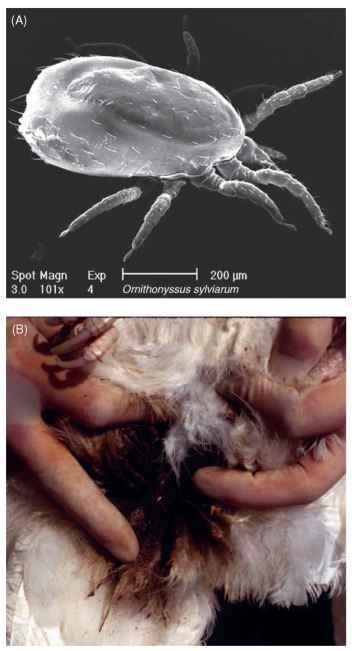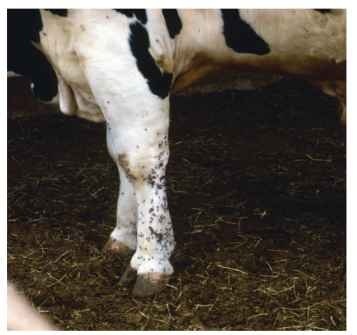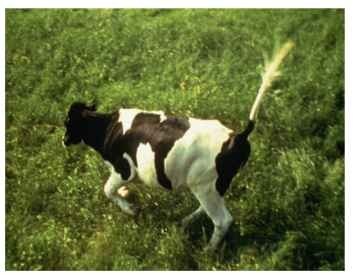Veterinary entomology deals with arthropod pests and vectors of disease agents to livestock, poultry, pets, and wildlife. It is T allied with the fields of medical entomology, parasitology, animal sciences, veterinary medicine, and epidemiology. The main pests of veterinary concern are sucking and biting lice, biting flies, nonbit-ing muscoid flies, bot flies, fleas, and Acari (mites and ticks).
ARTHROPOD GROUPS
Arthropods that affect animals can be categorized by the intimacy of their host association, and these range from permanent ectoparasites to pests that contact the vertebrate only briefly once every few days.
Permanent Ectoparasites
Some arthropods, such as lice and many parasitic mites, complete their entire life cycle on the host. All stages of sucking lice (Phthiraptera, suborder Anoplura) are mammal parasites and feed on blood. Biting lice (suborders Amblycera and Ischnocera) use either mammal or bird hosts. They feed mostly on skin, hair, and feather debris, but sometimes feed on blood as well. Lice tend to be abundant in cool weather or on animals stressed by poor nutrition or overcrowding. Many lice are specific to one or a few closely related hosts and cannot survive more than one to a few days away from the host. Transmission from host to host is mostly by direct contact.
Parasitic mites (Acari, suborders Mesostigmata, Acaridida, and Actinedida) are found on most groups of birds and mammals. Like lice, most are specific to one host species or a small group of related species. Several genera comprise what are commonly known as “mange mites.” Sarcoptes scabei. which causes sarcoptic mange, burrows at the surface of the dermis and exists in a number of races that generally are host specific to swine, dogs, and so on. Demodex mites, causing demodectic mange, live in follicles and can be important especially in immunocompromised hosts. Chorioptes and Psoroptes, causing chorioptic and psoroptic mange, include species of considerable importance for cattle, and wild and domestic sheep. The latter mites complete their development at the skin surface and do not actually burrow in the skin, although mites often are covered by scabs and are frequently called scab mites. Ornithonyssus mites are blood feeders and are especially important for wild and domestic birds, where populations may reach many thousands per host (Fig. 1). They occupy fur and feathers, traveling to the skin surface to feed regularly.

FIGURE 1 (A) Scanning electron micrograph of the northern fowl mite, O. sylviarum, a permanent ectoparasite of many birds, including domestic chickens. (B) The vent of a chicken, showing the blackened feathers typical of a heavy infestation. This hen has over 20,000 mites.
Some of the more advanced flies are also permanent parasites, and a number of species in three families hardly resemble flies at all because they have secondarily lost their wings (apterous). Members of the dipteran families Streblidae and Nycteribiidae live on bats, whereas members of the Hippoboscidae parasitize various birds and mammals. Some hippoboscids are economically important, such as the sheep ked, Mallophagus ovinus. In all these families, the adult female nurtures a single larva within her body until it is mature; this is a very unusual pattern for insects. After the mature larva exits the female, it promptly pupates on the host or nearby.
Semipermanent Ectoparasites
The semipermanent ectoparasitic arthropods do not complete the entire life cycle on the host, but they do spend at least several days at a time on a vertebrate. The hard ticks (Ixodidae) attach to feed for several days in each of the life stages. Although some, like the cattle tick Rhipicephalus (Boophilus) microplus, complete the entire life cycle on a single host, the most abundant and widespread species tend to use a separate host for each stage. In this case, the engorged tick falls off, molts, and then finds a new host by crawling up on vegetation and waiting for a passing vertebrate to which it attaches. This activity is known as questing. Often the larva hatches from an egg and attaches to a small host such as a rodent, whereas the nymph (the stage after the larval molt) or adult may attach to a larger host such as a deer. An example is the American dog tick Dermacentor variabi-lis. Adult female hard ticks take a large blood meal, produce a single large batch of eggs (typically several thousand), and then die.
Fleas (Siphonaptera) generally are on a host for most or all of the adult stage, and feed on blood. About 94% of flea species live on mammals, and the rest on birds. Flea eggs fall from the host pelage into a nest environment, where the larvae feed on organic debris and sometimes on excess blood produced by the adults. Fleas thus are often lacking on hosts that do not return to long-term bedding areas or nests.
Bot flies include important species in the dipteran families Oestridae, Gasterophilidae, and Cuteribridae. They spend nearly the entire year as immatures within the vertebrate’s body. Eggs, often laid on hairs, hatch and enter the host body.
Horse bot larvae (Gasterophilus) attach to the wall of the gastrointestinal tract for several months before they pass from the host with feces to pupate in soil. Cattle grubs (Hypoderma) migrate through the lining of the esophagus or spinal cord, depending on the species, and eventually form a cyst in the back. After a final period of maturation, larvae exit the cyst and fall into the soil to pupate. Bot fly adults lack functional mouthparts and depend entirely on reserves from the larval stage to sustain them for several days; in this brief time they must find mates and hosts. The invasion of vertebrate tissues by fly larvae is known as myiasis.
Certain other flies also are semipermanent parasites. Among mus-coid Diptera, the horn fly, Haematobia irritans, is on cattle most of its adult life, where adults of both sexes take many small blood meals each day. This distinguishes them from the vast majority of blood-feeding flies, which feed far less often. Horn flies leave the host to disperse and to lay eggs in very fresh dung, and then return to the host.
Occasional Parasites
The broad category of occasional parasites includes a range of arthropods. The most intimate host associations in this group include the soft ticks (Argasidae) and some blood-feeding mites such as the bird parasite Dermanyssus gallinae. In both cases, nymphs or adults hide in or near nest areas, sheltered in cracks and crevices or under debris; thus, they are closely associated with animals, although they contact them only periodically. They leave the hiding places, often at night, to feed for periods of 5-30 min, returning to the nest to digest the blood meal. Some soft ticks can withstand dry conditions and years without feeding.
Many serious biting fly pests spend the immature period away from the host, exploiting an entirely different resource base. It is common for larvae to feed on detritus in wet habitats, whereas the adults use plant nectar for energy and blood for egg development. For example, larvae of stable flies live in rotting vegetation, black flies in running water, horse flies and biting midges in swampy mud, or mosquitoes in ponded or slowly moving water. When the adults emerge, they take blood meals at intervals of 1-4 days, but they typically are in contact with the host for only a few minutes at a time. They leave the host to digest the blood in some sheltered resting location. For the higher Diptera (Cyclorrhapha), such as stable flies (Fig. 2) or tsetse flies, both sexes feed on blood, and multiple blood meals usually are needed to develop a batch of eggs (or, for tsetse, a single mature larva). In the lower Diptera (basal Brachycera and Nematocera) such as horse flies, blackflies, or mosquitoes, only females take blood, and most species require only a single large blood meal to develop an entire batch of eggs numbering 50-300. Some other pests in this general category do not feed on blood but visit the host to take meals of tears or other protein-rich secretions that are also used to develop eggs. A good example is the face fly, Musca autumnalis.

FIGURE 2 The stable fly, Stomoxys calcitrans. may attack animals in high numbers: there are approximately 200 flies feeding on the front leg of this bull. This species is illustrative of the occasional parasites because the adult flies blood-feed for only a few minutes every day or two, and larvae are in rotting vegetation away from the host animal.
HOW ARTHROPODS CAUSE
DAMAGE TO ANIMALS
There are several basic ways in which arthropods cause damage to animals, and the different mechanisms interact to impact agricultural production. Arthropod damage to plant crops often is evident to consumers, who react with disgust to cabbage leaves damaged by loopers, corn earworm larvae on an ear of corn, or scale insects on citrus fruit.
In contrast, arthropod damage to animal production tends to be hidden from the consumer because the product is purchased in the form of jugs of milk or wrapped packages of butchered meat. Nevertheless, losses are serious for producers, and costs are passed on to consumers.
Loss of Blood and Tissue Fluids
Many arthropods ingest blood, usually for egg development. Impact of blood loss on the animal reflects the style of feeding and the number of arthropods. Mosquitoes may canulate a vessel, and hosts generally lose only the blood mosquitoes ingest. In contrast, some biting flies macerate the capillary beds of the skin to feed from blood pools. They not only tend to inflict more painful bites, but the bites themselves also lead to a larger quantity of blood loss per feeding insect. For example, horse flies (Tabanidae) may directly remove over 200 ml day-1 from a host in a pasture, but blood continues to run from the wound for a period of time, often being fed on by other flies. Many hard ticks (Ixodidae) increase in weight by 100-fold or so as they feed for 7-10 days. Females of very large species of ticks may contain over a milliliter of blood at a time, and hundreds may be attached to a single host animal. Blood or fluids such as lymph are metaboli-cally “expensive” for a vertebrate to produce. Such loss is reflected in reduced feed conversion efficiency, which occurs when animals eat more for a given yield of meat or eggs. Insect feeding also causes significantly lower weight gains or milk production. Losses of 10-20% feed conversion, 0.1-0.2 kg day-1 weight gain (cattle), and 5-10% loss in milk yield are not uncommon for animals under heavy attack.
Pain and Interference with Activities
Pain and irritation caused by arthropod attack force animals to alter their feeding or activity patterns and to engage in a number of sometimes vigorous behaviors to defend themselves. There may be economic loss as well, since animals are not feeding normally and must expend energy that might otherwise be directed toward growth or reproduction. For example, stable flies (Stomoxys) and face flies, as well as other biting flies, can cause animals to retreat into groups for refuge. In groups, insect attack rates usually are lower per host (the herd dilution effect), particularly for the animals that occupy the interior of an aggregation. Animals also may enter woods or bodies of water in an apparent attempt to escape insects. Cattle pursued by adults of cattle grubs (Hypoderma) experience no immediate pain from the flies, which cannot bite. The female flies try merely to deposit eggs on the cattle hair at the base of the legs. Still, cattle exhibit an interesting, stereotypical behavior known as “gadding” (Fig. 3). The animals run at full speed with tails raised straight into the air, which expends energy and may cause accidental injury.
Although pests such as house flies may not cause direct losses to the animals, they are produced near animal operations and thus are a veterinary entomology problem. Excessive numbers (” excessive ” admittedly is a subjective term) of nuisance arthropods cause great annoyance to people living nearby, and thus constitute serious public relations and legal problems for producers. Public health agencies can close facilities unable or unwilling to mitigate such a problem.
Allergic Responses to Saliva
Blood-feeding arthropods possess a potent arsenal of chemicals in their saliva to maintain blood flow (vasodilators, anticoagulants) and sometimes have anesthetics to reduce host defensive response. Like humans, animals can develop allergies to these compounds. Horses commonly react to biting midge (Culicoides) feeding with an allergic reaction called Queensland itch or sweet itch, resulting in skin inflammation and hair loss. Mass emergences of the blackflies Simulium

FIGURE 3 “Gadding” behavior (note the tail held up in the air) by a calf being attacked by cattle grub flies (Hypoderma spp.). Vertebrate host behavior can be altered by parasites.
arcticum in Canada and Cnephia pecuarum in the valley of the southern Mississippi River have resulted in the deaths of livestock, probably from allergic responses as well as blood loss. Larvae of sheep blowfly (Lucilia) feed near the skin surface, especially where the wool is wet, and can contribute to a toxic shock-type syndrome fatal to infested sheep. Pets may develop serious allergies to fleas, with resulting hair loss and other symptoms.
Product Damage
Arthropods sometimes cause direct damage to parts of the animal desired by people. For example, cattle grub (Hypoderma) larvae form large cysts in the backs of cattle. They cut a hole in the skin to breathe, and this skin is the thickest on the animal. Although the holes heal after the larva exits, the scarred skin is less valuable for leather. The presence of larvae also can affect the quality of the meat in this area of the animal, which is the part where the best steaks come from, and damaged meat sometimes must be trimmed at the slaughterhouse. Mites such as Psoroptes and Sarcoptes, as well as many lice, often result in irritation, rubbing, and gross loss or damage to hair and wool.
Cosmetic damage, including rashes or minor hair loss, can be predictably serious to the owner of a pet or a show animal. However, cosmetic damage also can cause losses in animal agriculture out of proportion to actual damage. An example of this is the condition ” gotch ear” in cattle caused by the Gulf Coast tick Amblyomma maculatum in the southern United States. Damaged ear cartilage is cosmetic, but causes the animals to be placed in an “odd lot,” with per-pound prices less than those of undamaged cattle.
Restricted Trade
Many pests have distinctive distributions, and preventing movement or dispersal into new areas is of paramount importance. Cattle ticks (Boophilus) and screwworms (Cochliomyia hominivorax) were eradicated from the southern United States in the 20th century, but the ticks inhabit Mexico and countries south of it, and screwworms persist on some Caribbean islands and South America. The U.S. habitat obviously is still suitable. Without complex systems of animal quarantine,treatment, and examination, it is certain these pests would reestablish in the United States.
Exotic arthropods pose a great threat either as direct pests or vectors of disease agents such as those that cause heartwater or African swine fever. The Office International des Epizooties lists diseases of risk for animals worldwide, and one of those on List A (greatest risk) is bluetongue. This viral disease of ruminants, such as cattle and sheep, is transmitted by biting midges, and is endemic in the United States. Trade restrictions from bluetongue cost the U.S. cattle industry many millions of dollars annually, even though cattle themselves do not usually develop obvious disease. Some major trading partners lack bluetongue, and their agricultural authorities fear an impact of bluetongue on their sheep industries, because sheep are more susceptible than cattle are. Western Europe is struggling with trade issues due to a recent (especially since 2006), persistent, spreading outbreak of bluetongue extending as far north as northern Germany and England.
Diseases
A number of serious animal disease agents are transmitted by arthropods. The worst of these are tropical, and they cause death and heavy production losses in the affected countries. African trypano-somiasis causes a wasting-type disease known as nagana in animals and sleeping sickness in humans, and Theileria parva, called East Coast fever, can cause 90-100% mortality in affected cattle in eastern Africa. People in developed countries tend to underestimate the true value of animals in the developing world. Animals are vital there not only for protein-rich food, but for draft and transportation purposes, and as wealth. They are the basis of many pastoral peoples’ economies, and the economic impact of some of these animal diseases can exceed even the impact of similar, serious human pathogens.
Temperate zones also have some rather important arthropod-transmitted animal disease agents, including Anaplasma, dog heart-worm, and equine infectious anemia virus. In the United States and Europe, the direct effects of arthropods on animal production generally exceed losses caused by arthropod-transmitted diseases. However, the role of wild animals as natural reservoirs of pathogens that incidentally infect people is very important in both temperate and tropical zones. Diseases that cycle naturally in animal populations and occasionally infect people are called zoonoses. Zoonoses comprise some of the more notorious arthropod-related human health problems. They include plague (maintained in rodents and transmitted by fleas), Lyme disease (maintained in rodents and transmitted by ticks), and St. Louis encephalitis (maintained in birds and transmitted by mosquitoes). Previously unknown tick-borne ehrlichioses (caused by intracellular bacteria-like organisms in the genus Ehrlichia) have been recently discovered infecting humans in the United States. They are zoonotic in origin and typify a category of “emerging” human diseases that is now of great interest in the medical community.
